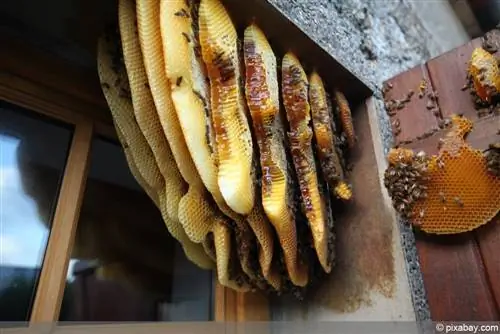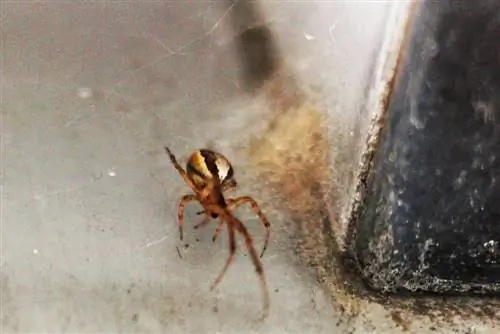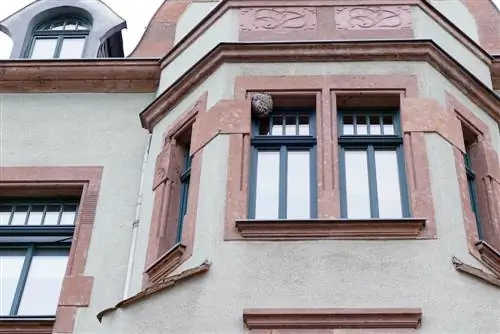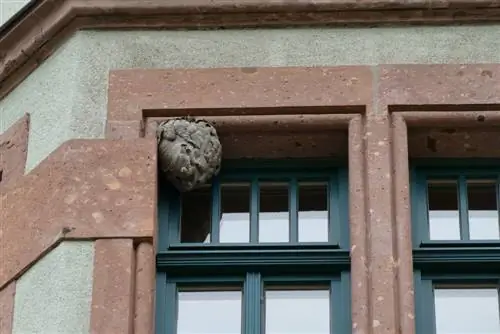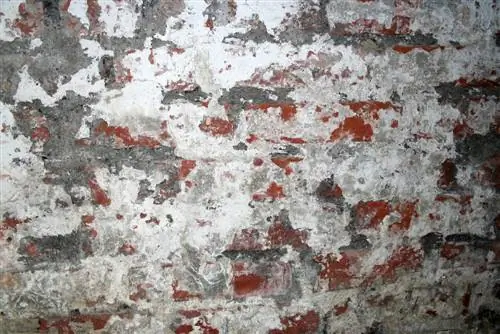- Author admin [email protected].
- Public 2023-12-17 03:39.
- Last modified 2025-06-01 06:48.
Many wild and honey bees, as cultural followers, seek proximity to humans in order to nest here. The dark cavity in the roller shutter box is just right for the insects to build their nests. Affected residents are now faced with deciding the right course of action, beyond irrational fears. This guide will familiarize you with various options for safely removing a bee nest from the roller shutter box without harming people or animals.
Are bees dangerous?
Can they sting? - This is the question that immediately comes to mind when the buzzing of bees comes from the roller shutter box. However, this question is just as paradoxical as the question of whether dogs bite. The suggestion here is that the four-legged friends are just running around to take advantage of every opportunity for a hearty bite into human legs or arms. Of course, this is no more the case than wild bees and honey bees fly around in a bad mood looking for people to sting.
In fact, bees are equipped with a defensive stinger that has developed from former laying tubes. Since males did not have an ovipositor at any time in evolution, they do not have a defensive stinger and cannot sting. Female bees never use their stingers against people out of pure aggressiveness, but only in extreme distress when there is no possibility of escape. The sting in the skin also marks the end of the bee. The stinger is barbed so that the entire stinging apparatus is torn out of the insect and the bee dies. As long as bees and bumblebees do not feel threatened and see a way out, people are spared from their stings.
From this perspective, there is no reason to panic if a bee's nest is discovered in the roller shutter box. The bees do not pose an immediate danger. You can wait in peace until the breeding business is finished and the bees leave the nest. If there are small children, seniors in need of help or allergy sufferers in the house, continue reading these instructions. Below you will find useful procedures for removing a bee nest from the roller shutter box.
Bees are protected
The global extinction of insects continues to gain momentum and does not spare wild bees and honeybees. Since 1952, the number of domesticated bee colonies alone has almost halved from 2.5 million to 1.4 million. Of the 560 wild bee species in Europe, more than half are threatened. The dramatic decline has prompted lawmakers to place bees under nature protection as a particularly protected species.

Specifically, it is strictly forbidden to catch bees, kill them, damage their nests or even disturb the insects. Violations are punished with fines of up to 60,000 euros. If you want to remove a bee's nest from the roller shutter box, special procedures are required that are in accordance with the Nature Conservation Act.
First point of contact for beekeeping association
Being able to tell the difference between wild bees, domestic honey bees and farmed, high-performance bees among the many hundreds of bee species is the responsibility of an expert. If a colony of bees has obviously chosen your roller shutter box as a nest, contact the local beekeeping association. Here you can find out which beekeepers in your area will relocate a swarm of bees for free. The experts are also available to give you advice and support on how to properly handle wild solitary bees.
Relocate instead of destroying
Bees only nest in the roller shutter box when they are denied species-appropriate and natural options. Most of them are wild bees or solitary bees who would rather build their nest in the security of rotten tree trunks than in the unsafe and noisy environment of a roller shutter box. This is especially true if the roller shutter is raised and lowered again every day. If you offer the insects an alternative nesting place outside the home, the workers will quickly discover it. Following a thorough inspection, the little people relocate. With this strategy you can get rid of the bees' nest in the roller shutter box without coming into conflict with the Federal Nature Conservation Act, harming the insects or being stung.
You can build species-appropriate nesting aids yourself or purchase them from specialist retailers for little money. Below we will introduce you to recommended models that motivate bees to move out of the roller shutter box:
Nistwoods
Well-seasoned hardwood of all kinds is perfect as a home for cavity-dwelling wild bees. Beech, oak, ash and the wood of fruit trees can be transformed into a tempting nesting place in just a few simple steps. In contrast, softwood is too soft to work with and swells when exposed to moisture, which could crush larvae or cocoons. How to build a nesting aid yourself:
- Use pieces of tree trunk, thick branches or beams that have been dried and debarked for several months
- Use a wood drill to create drill holes with a diameter of 2.5 to 8 mm
- Depth of the drill holes up to the drill chuck of the drilling machines
- Do not drill completely through the piece of wood
- Each hole is at least 10 times longer than it is wide
Please make sure there is a sufficient distance of 1 to 2 cm between the drill holes so that no cracks form. Move the drill back and forth until the walls in the nest hole are smooth. Sand any protruding wood fibers at the entrance. Residual drilling dust disappeared after light tapping.
Tip:
Plexiglas glass tubes are completely unsuitable as nesting aids for insects. Within the impermeable material, a large proportion of the bee brood dies due to fungal infection.
Hollow Stems
Bees leave the populated roller shutter box in no time if there is a vertical nesting aid made of hollow stems nearby. Elderberry sticks, bamboo tubes, blackberry vines or mullein stems are ideal for this purpose. How to construct an enticing bee hotel out of stems:
- Cut the selected plant stems into pieces with a length of 15 to 20 cm
- Place the stems upright in a container that is open at one end and closed at the other
- Remove any marks beforehand using a cordless screwdriver or a screwdriver
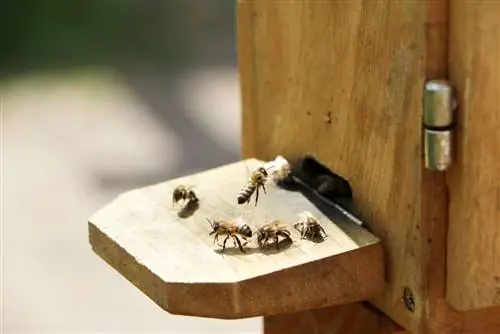
To prevent the plant stems from being pulled out of the container by bird beaks, coat the bottom end with wood glue and press it against the back wall.
Strong interlocking tiles
If there are interlocking tiles nearby, bees quickly turn their winged backs to the uncomfortable, noisy nest in the roller shutter box. The bricks are made of fired clay with around 10 to 12 parallel hollow chambers. These run through the flat longitudinal axis and have a round entrance at both ends. With a diameter of 6 to 8 mm, the tubes are just right for cavity-dwelling wild bees to raise their offspring in. This is how a bee hotel is constructed from interlocking bricks:
- Integrate bricks upright into an existing insect house
- Alternatively, stack it on a pallet or beam to form a tower or incorporate it into the drywall
- Close the tubes on one side with plaster, untreated upholstery wool or organic cotton wool
Sharp-edged or deformed openings can be shaped with a masonry drill. Commercially available interlocking tiles are 40 cm long and can be divided into two halves using an angle grinder. The tiles are available from roofing companies, online or from the manufacturer Creaton.
Setting up a nesting aid - tips for protecting yourself from predators
A sunny, warm location on the south, west or east wall of the house is a good place to install a nesting aid. Ideally, the location is well protected from wind and rain. Shady locations are unsuitable for a bee hotel. Nesting aids that are hung in trees, shaded and dangling in the wind leave bees out of focus and prefer to stay in the roller shutter box.
So that no birds attack the bee nursery, equip the nesting aid with protection. Blue plastic nets and wire mesh with a mesh size of 3 x 3 cm, which are placed at a distance of 20 cm, have proven to work well in practice. The very close-meshed bird protection nets, on the other hand, are far too finely woven for bees to pass through the mesh to get to their nest. Furthermore, the green nets have proven to be death traps for birds and hedgehogs.
Tips for prevention
Bees don't even consider an insect-proof roller shutter box as a nesting place. Therefore, subject the roller shutter with box to a close inspection in March, in good time before the queen bees start looking for resistance. You can carry out the following preventive measures yourself:
- Provide the stop strip on the roller shutter with a brush strip or profile rubber seal
- Replace roller shutter stoppers with brush strips
- Glue possible loopholes with plaster, silicone or adhesive tape
Clove oil has a repellent effect on bees, bumblebees and wasps. Coat the roller shutter box, window frame and joints with essential oil and refresh the paint regularly until July. Please note that according to the Nature Conservation Act, all defensive measures must end as soon as bees have started building their nests.

